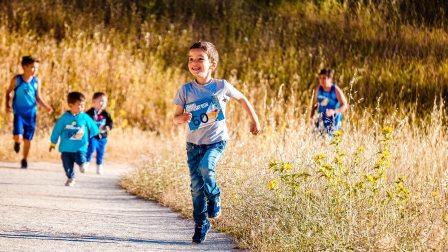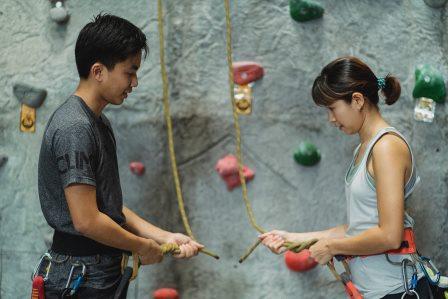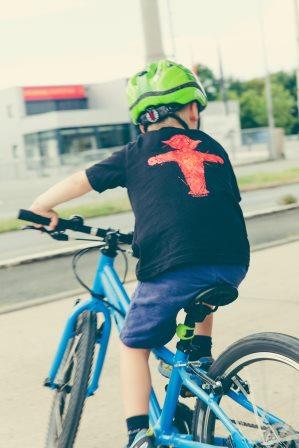Sport, exercise and motivating children and young people with bleeding disorders like haemophilia and VWD to keep fit were the topic of a lively webinar for Bleeding Disorders Awareness Week in 2020.

Jo and Robyn from the Haemophilia Treatment Centre at Westmead, NSW were joined by Andrew Selvaggi, whose journey to becoming a personal trainer has inspired many other young people with haemophilia. They talked through the issues, gave tips and answered questions from the audience.
Watch the video of the webinar
Facilitator: Natashia Coco, Haemophilia Foundation Australia
Speakers:
Jo (Johanna) Newsom, Physiotherapist, The Children’s Hospital at Westmead, NSW
Robyn Shoemark, Clinical Nurse Consultant, Haematology/Haemophilia, The Children’s Hospital at Westmead, NSW
Andrew Selvaggi, who has severe haemophilia with inhibitors
What should young people and children be aiming for with exercise?
Jo Newsom noted that the current guidelines recommend that all young people from the age of 5 years up until they are adults should be aiming at around 60 minutes of moderate physical activity daily. This is activity, explained Jo, ‘where you are just huffing and puffing a little bit and having a little trouble talking in full sentences’. This exercise can be broken up during the day and can include incidental activity, like walking up the stairs or walking briskly from the carpark, as well as structured sports time.
The time for physical activity is matched with recommended screentime on devices, video games and TV – no more than 2 hours daily.
Why is exercise good for us?
‘It’s not just about maintaining fitness and body weight, but about keeping us strong and flexible and agile, helping us maintain our balance and co-ordination so that our risk of falls and injury is reduced,’ said Jo. ‘And in the case of haemophilia, it’s so that our risk of bleeding is reduced because our muscles are more flexible and stronger and better able to protect our joints.’
Exercise also makes us feel good. ‘It releases all sorts of happy endorphins,’ explained Jo.

Jo and Robyn are often asked how to exercise safely with a bleeding disorder. International guidelines talk of ‘risk’. High contact sports have a high risk of injury and are often not recommended for people with bleeding disorders. Moderate contact sports involve bumping, like soccer, or falling and whacking yourself as you fall, like skiing or snow-boarding. No contact sports include activities like swimming or golf or orienteering where physical contact is more unlikely.
In reality, young people with bleeding disorders like to play all of these sports and the Haemophilia Treatment Centre team would discuss the implications of any sport you want to play with you.
Involvement in sport changes as you grow. In primary school, children will hopefully focus on skills development, such as eye-hand co-ordination or balance and flexibility – throwing, catching, batting, etc. This exposes you to a range of sports and you are in a better place to choose a sport that you like. Then as you reach your teenage years, you will specialise and choose sports that you are interested in. You are much more likely to continue to play a sport that you enjoy and you may like the sport for various reasons – perhaps because of the friends you make or the competition or the activity itself.
How to start a new sport? Slowly! said Jo. It takes a little while for your body to adapt to new movements and muscles to recover. Also, starting in a structured environment is important for safety: with the right protective gear for the sport, playing on the right kind of surface, and where there is a referee or umpire to make sure the rules are followed. This might involve joining a club to start a new sport, e.g. soccer or Little Athletics.
Involve your Haemophilia Treatment Centre team when you are starting a new sport. With prophylaxis and new treatments, more options are available to you than in previous generations. Working with your HTC will help to protect you from injury and bleeds. The team will be able to look at your individual situation and see what needs to be modified and if there is any other protective gear or bracing or splinting that might help if you have joint or muscle problems. It might also involve caution with some sports, such as weight training, because bones are soft in young people. But the team are keen to support you to do the sports that you love.
Robyn explained that the HTC will also discuss timing your factor treatment – having your factor before you play, to make sure you are best protected when you are most active. And don’t forget about diet and sunshine for healthy bones and muscles!
Rehabilitation after a bleed is also very important. Recovery will be very individual, but probably slower than you would prefer! Going back to the sport too soon can cause rebleeding into the same injured joint or muscle, which is why your HTC will be cautious about jumping back into play. Robyn highlighted that it is important to treat your bleed when it occurs – and ‘treatment’ can also involve first aid PRICE (Protection, Rest, Ice, Compression, Elevation) as well as factor.
Andrew Selvaggi’s personal story has inspired many young people with haemophilia. He joined Jo and Robyn in talking about what he has learned through tackling the challenges of living with haemophilia A and inhibitors. Andrew explained that he had a different experience of treatment and sport when he was a child and teenager to young people with haemophilia today. Now 33 years old, he has been a personal trainer for 8 years and is a senior project manager at a university. His journey to reach this point has been quite extraordinary.
For the first 12 years of his life there was no effective treatment for his inhibitors, and he was wheelchair bound with a long list of bleeding complications. As time progressed, treatments improved and his HTC team supported him to make some fairly radical changes to his life. By the age of 20 he had lost 30 kilograms of weight and had ‘got my body and my mind on track’.
‘Our bodies are made to move, and the more we move, the better we are,’ said Andrew. ‘The more sedentary we are, the more sluggish and slow we feel and this has mental impacts. At that time before I lost that weight, I was stuck in a wheelchair. I was bleeding a lot and I was very unhappy and I didn’t know why. It was a vicious cycle, purely because the large amount of weight I was carrying put such a strain on my body – and I probably wasn’t doing the right rehab.’
When Andrew lost the weight and started exercising more, his bleeding episodes decreased from two to three per week to two to three per month or two months. He had not been able to develop the muscle mass and strength or skills that other young people develop during childhood – the perception of himself in space and the mind-muscle connection – and is still working on this today, in spite of his relative physical fitness.
Andrew’s message to young people with haemophilia: ‘Being sedentary isn’t something related to haemophilia anymore. Being active is for everyone in the world, including people with haemophilia. With the right treatment plan and the right support and oversight from your HTC team, you can really be active and healthy with haemophilia.’ He gave examples from around the world of people with haemophilia who are pushing the boundaries with sport.

The session then moved to a Q & A panel discussion, with questions from the audience.
What is your advice for kids when they don’t want to do any exercise?
How do you deal with a physio who doesn’t know anything about haemophilia?
What can girls do to manage sport if they have heavy periods?
What do I need to tell the coach?
Many thanks to Jo, Robyn and Andrew for putting together such a great session!
If you would like more information about sport and exercise for young people with bleeding disorders, speak to your Haemophilia Treatment Centre. Contact details of HTCs are on the HFA website.
You can find more information about sport and exercise, along with personal stories, on the HFA Factored In youth website.
On the move with haemophilia is an education resource for parents, teachers and coaches on sport and exercise in young people with haemophilia. Developed by InVIVO Academy in collaboration with HFA and Haemophilia Foundation of New Zealand.
Haemophilia Foundation Australia acknowledges the Traditional Owners and Custodians of Country throughout Australia, the land, waters and community where we walk, live, meet and work. We pay our respects to Elders past and present and extend that respect to all Aboriginal and Torres Strait Islander peoples.
Sign up for the latest news, events and our free National Haemophilia magazine